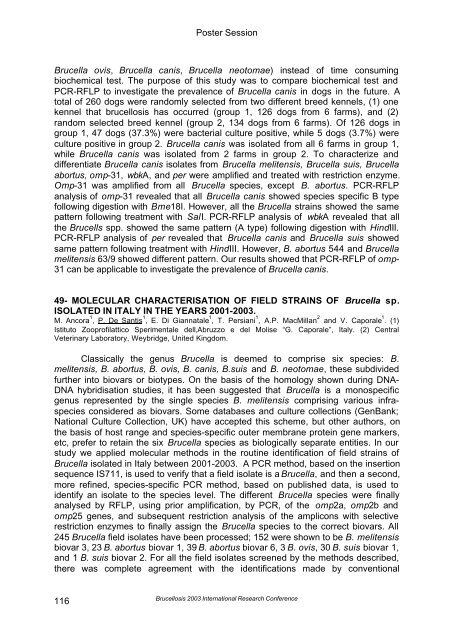Brucellosis 2003 proceedings - PHIDIAS
Brucellosis 2003 proceedings - PHIDIAS
Brucellosis 2003 proceedings - PHIDIAS
You also want an ePaper? Increase the reach of your titles
YUMPU automatically turns print PDFs into web optimized ePapers that Google loves.
Poster Session<br />
Brucella ovis, Brucella canis, Brucella neotomae) instead of time consuming<br />
biochemical test. The purpose of this study was to compare biochemical test and<br />
PCR-RFLP to investigate the prevalence of Brucella canis in dogs in the future. A<br />
total of 260 dogs were randomly selected from two different breed kennels, (1) one<br />
kennel that brucellosis has occurred (group 1, 126 dogs from 6 farms), and (2)<br />
random selected breed kennel (group 2, 134 dogs from 6 farms). Of 126 dogs in<br />
group 1, 47 dogs (37.3%) were bacterial culture positive, while 5 dogs (3.7%) were<br />
culture positive in group 2. Brucella canis was isolated from all 6 farms in group 1,<br />
while Brucella canis was isolated from 2 farms in group 2. To characterize and<br />
differentiate Brucella canis isolates from Brucella melitensis, Brucella suis, Brucella<br />
abortus, omp-31, wbkA, and per were amplified and treated with restriction enzyme.<br />
Omp-31 was amplified from all Brucella species, except B. abortus. PCR-RFLP<br />
analysis of omp-31 revealed that all Brucella canis showed species specific B type<br />
following digestion with Bme18I. However, all the Brucella strains showed the same<br />
pattern following treatment with SalI. PCR-RFLP analysis of wbkA revealed that all<br />
the Brucells spp. showed the same pattern (A type) following digestion with HindIII.<br />
PCR-RFLP analysis of per revealed that Brucella canis and Brucella suis showed<br />
same pattern following treatment with HindIII. However, B. abortus 544 and Brucella<br />
melitensis 63/9 showed different pattern. Our results showed that PCR-RFLP of omp-<br />
31 can be applicable to investigate the prevalence of Brucella canis.<br />
49- MOLECULAR CHARACTERISATION OF FIELD STRAINS OF Brucella sp.<br />
ISOLATED IN ITALY IN THE YEARS 2001-<strong>2003</strong>.<br />
M. Ancora 1 , P. De Santis 1 , E. Di Giannatale 1 , T. Persiani 1 , A.P. MacMillan 2 and V. Caporale 1 . (1)<br />
Istituto Zooprofilattico Sperimentale dell‚Abruzzo e del Molise “G. Caporale”, Italy. (2) Central<br />
Veterinary Laboratory, Weybridge, United Kingdom.<br />
Classically the genus Brucella is deemed to comprise six species: B.<br />
melitensis, B. abortus, B. ovis, B. canis, B.suis and B. neotomae, these subdivided<br />
further into biovars or biotypes. On the basis of the homology shown during DNA-<br />
DNA hybridisation studies, it has been suggested that Brucella is a monospecific<br />
genus represented by the single species B. melitensis comprising various infraspecies<br />
considered as biovars. Some databases and culture collections (GenBank;<br />
National Culture Collection, UK) have accepted this scheme, but other authors, on<br />
the basis of host range and species-specific outer membrane protein gene markers,<br />
etc, prefer to retain the six Brucella species as biologically separate entities. In our<br />
study we applied molecular methods in the routine identification of field strains of<br />
Brucella isolated in Italy between 2001-<strong>2003</strong>. A PCR method, based on the insertion<br />
sequence IS711, is used to verify that a field isolate is a Brucella, and then a second,<br />
more refined, species-specific PCR method, based on published data, is used to<br />
identify an isolate to the species level. The different Brucella species were finally<br />
analysed by RFLP, using prior amplification, by PCR, of the omp2a, omp2b and<br />
omp25 genes, and subsequent restriction analysis of the amplicons with selective<br />
restriction enzymes to finally assign the Brucella species to the correct biovars. All<br />
245 Brucella field isolates have been processed; 152 were shown to be B. melitensis<br />
biovar 3, 23 B. abortus biovar 1, 39 B. abortus biovar 6, 3 B. ovis, 30 B. suis biovar 1,<br />
and 1 B. suis biovar 2. For all the field isolates screened by the methods described,<br />
there was complete agreement with the identifications made by conventional<br />
116<br />
<strong>Brucellosis</strong> <strong>2003</strong> International Research Conference
















